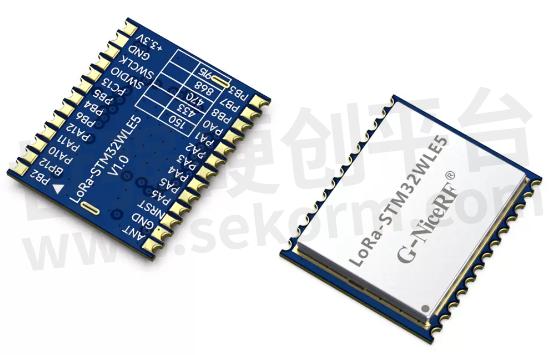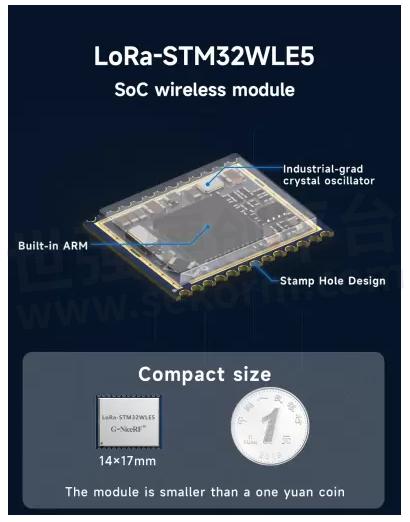A Brief Discussion on the Data Security Defense Mechanism of the LoRa-STM32WLE5 System-on-Chip (SoC)

As IoT devices become more widespread, billions of devices are communicating over wireless networks, transmitting vast amounts of sensitive data. While this large-scale device connectivity brings convenience, it also introduces significant security risks. System-on-Chip (SoC) solutions integrate wireless communication, processors, storage, and security mechanisms into a single chip, offering a highly integrated solution for IoT applications. This design greatly simplifies the hardware development process while enhancing the overall performance and security of devices.SoCs not only meet the demands of long-range, low-power wireless communication, but also ensure comprehensive data security during transmission, storage, and processing through advanced encryption technologies. This provides robust protection for the stability and security of IoT devices. Now, let's discuss some of the security mechanisms in SoC systems.
The LoRa-STM32WLE5 is an SoC module developed by NiceRF, utilizing ST's STM32WLE5 chip. Based on the high-performance Arm® Cortex®-M4 32-bit RISC core, it implements a complete set of DSP instructions and an independent Memory Protection Unit (MPU). The module leverages LoRa modulation to offer long-range, low-power, and high-sensitivity wireless communication capabilities. In addition, the design incorporates robust security mechanisms to ensure the safety of both devices and data.

SoC Integrated Design: Reducing the Possibility of System Vulnerabilities
The LoRa-STM32WLE5, as an SoC module, benefits significantly from its highly integrated design, which is a key advantage in terms of security. Compared to traditional discrete systems, the SoC architecture reduces the number of physical connection points between system components—often targets for attackers. By integrating the processor, communication module, and security mechanisms into a single chip, the STM32WLE5 SoC significantly reduces external attack entry points, fundamentally lowering the number of potential vulnerabilities.
In IoT devices, security threats are often discovered through interaction vulnerabilities between different system components. The SoC architecture effectively eliminates this complexity, simplifying the system's security design and reducing the likelihood of security vulnerabilities being exposed.
256-Bit AES Hardware Encryption: A Robust Defense for Data Transmission
As IoT devices, wireless data transmission must inevitably face various attack risks. The LoRa-STM32WLE5 module enhances data transmission security by integrating 256-bit AES hardware encryption technology. AES (Advanced Encryption Standard) is a widely used symmetric encryption algorithm, and AES-256 is considered to have a very high level of resistance to decryption, capable of meeting encryption needs for decades to come.
The advantage of hardware encryption lies in its efficiency and security compared to software encryption solutions. Hardware encryption is executed directly at the chip level, allowing data to be transmitted without requiring complex computations by the CPU, thereby avoiding potential processor vulnerabilities and attacks at the software level.
In practical applications, such as remote monitoring systems in smart cities, thousands of cameras transmit real-time video and environmental data through LoRa networks. If this data were not encrypted, it would be at high risk of interception and tampering. The hardware encryption feature of the LoRa-STM32WLE5 module provides exceptionally strong protection for these critical data streams, ensuring the confidentiality and integrity of data during transmission.

PCROP Read/Write Protection: The Key to Firmware Security
In addition to transmission security, the security of device firmware is equally critical. The LoRa-STM32WLE5 SoC incorporates PCROP (Proprietary Code Read-Out Protection) technology, effectively preventing reverse engineering and malicious tampering of the code.
PCROP technology can lock specific storage areas on the chip, making them unreadable or unmodified. Even if a hacker attempts to extract data from the chip through physical means, they cannot bypass the protection provided by PCROP, ensuring the security of the device firmware and core algorithms. This is crucial for protecting intellectual property and preventing firmware tampering.
In industrial control systems, devices often operate in unattended environments, where attackers may attempt to access the device's firmware to inject malicious code or extract proprietary algorithms. PCROP technology effectively blocks such attacks, ensuring the integrity and exclusivity of the device firmware.
Memory Protection Unit (MPU): Preventing Unauthorized Access
The STM32WLE5 SoC features an integrated Memory Protection Unit (MPU), providing fine-grained memory management capabilities for the device. The MPU allows the system to restrict memory access for each task, preventing unauthorized access and memory conflicts between tasks. This function is especially important in multi-task operating systems, as it prevents malicious tasks from affecting critical system processes, ensuring the normal operation of the device.
For instance, in smart home applications, multiple sensors and controllers share system resources to process data. If one task attempts to access a memory area it does not own due to a program vulnerability, the MPU will immediately block this behavior, preventing disruptions to other tasks and avoiding system crashes or further exploitation.
The LoRa-STM32WLE5 SoC module is not just a wireless module with excellent communication capabilities, but also an efficient SoC solution with multiple security mechanisms integrated. Through a combination of AES hardware encryption, PCROP read/write protection, and MPU memory management, it provides comprehensive security for IoT devices, ensuring data, firmware, and system safety at all levels.
- +1 Like
- Add to Favorites
Recommend
- G-NiceRF’s New LoRa Spread Spectrum Modulation SOC Wireless Module LoRa-STM32WLE5 with Built-in ARM and Industrial Grade Crystal Oscillator
- G-NiceRF LoRa Backscatter Device LoRa1276-C1 Provides Long-Range Communication with Low-Power
- G-NiceRF LoRa1121 Module Newly Released: Enables Multi-Band Compatibility and Satellite Communication Functionality
- LoRa-STM32WLE5 Module with Open Area Transmission Distance Exceeds 5000 Meters, Sleep Current Less Than 2µA
- LoRa-STM32WLE5 SoC Wireless Module: Achieving Ultra-Long Range and Low-Power High-Performance Wireless Communication
- The Several Noteworthy Features of LoRa-STM32WLE5 SOC Module
- G-NiceRF‘s FCC Certified Products for Wireless Transceiver Module: LoRa1276-915, RF2401PRO, RF2401F20, RF4463PRO
- What Features Should a Portable Walkie-Talkie Module Have? Take G-NiceRF SA828 for An Example
This document is provided by Sekorm Platform for VIP exclusive service. The copyright is owned by Sekorm. Without authorization, any medias, websites or individual are not allowed to reprint. When authorizing the reprint, the link of www.sekorm.com must be indicated.





























































































































































































































































































































































































































































































































































































































































































































































































































































































